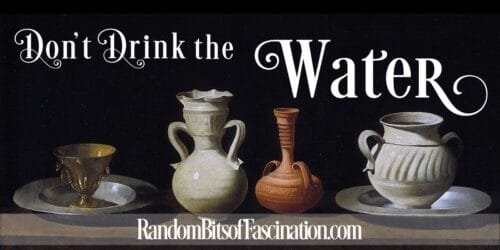Don’t Drink the Water: Herbal Cooling Waters

You all know me well enough by now, that I love old recipes and what one can learn by taking a deep dive into that rabbit hole. Yeah, I know there’s a danger I might never come out, but I have learned to throw out a life line when I’m going in and make sure there’s someone around who can grab me by the shoulders when the timer goes off and my rabbit hole time runs out.

So what precipitated this dive? A trip to the grocery store and the mindboggling array of beverages there.
Just the flavored waters alone are mind boggling! Which of course got me wondering just how recent a phenomenon are flavored waters. And I don’t mean flavored drinks made with water (that’s another post, of course, LOL), but water with a bit of flavor to make it ‘refreshing’.
The answer is that they are older than you think.
I scoured my go-to period recipe book and had a difficult time turning up anything that wasn’t alcoholic. Of course, that made sense as the Georgian era saw a great deal of alcohol consumed, much of it very diluted with other ingredients. I hit pay dirt, though, when I dug into cookbooks specializing the confectionary. Who knew?
Clermont offered several recipes for Cooling Waters without Ice which would absolutely be at home on the grocery shelves of today.
Eau rofraichissante de Fenouil, et de CerfeuiL Cooling Waters of Fennel, and of Chervil.
These are done simply, by steeping some of either in hot water till it has the taste of the herbs sufficiently; add what quantity of sugar you think proper, and keep it in a cool place a good while before using: the same is done with any other kind of herbs, and in general with all sorts of fruit used in confectionary; also with the syrups of liquid preserves, mixing some of the liquor with water and sugar just sufficient to make it palatable: it may be either iced or not.
~Clermont, 1776
Fennel is a vegetable/herb with a licorice taste to it. Chervil is an herb that looks like parsley. It tastes like a cross between tarragon and parsley with hints of licorice or anise. While I’m not a huge fan of licorice, I can see this suiting a modern palate.
Nutt, a famous confectioner of the day offered his take on Lemon Water that sounds so much like a modern flavored water I had to wonder that it was from 1807.

In case you’re wondering, capillaire is a honey based syrup made from maidenhair leaves (which was also used as a cough remedy).
I think it is fascinating foods that seem rather modern have such a rich history.
References
Clermont, B., and Menon. The Professed Cook ; Or, the Modern Art of Cookery, Pastry, and Confectionary, Made Plain and Easy … including a Translation of Les Soupers De La Cour … By B. Clermont … The Third Edition, Revised and Much Enlarged. London: W. Davis, Etc., 1776.
Nutt, Frederick. The Complete Confectioner ; Or, the Whole Art of Confectionary: … By a Person, Late an Apprentice to the Well-known Messrs. Negri and Witten ..London: Printed for the Author, 1807.

I think I read somewhere where one of the characters drank barley water when they were ill. You always have the most fascinating posts. Thanks for sharing. I hope Texas can dry out soon. Blessings.